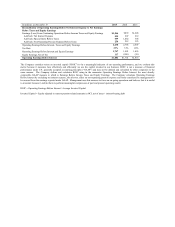International Paper 2015 Annual Report Download - page 21
Download and view the complete annual report
Please find page 21 of the 2015 International Paper annual report below. You can navigate through the pages in the report by either clicking on the pages listed below, or by using the keyword search tool below to find specific information within the annual report.4
of on-going international negotiations including a
Conference of the Parties (COP21) to the Kyoto
Protocol. COP21 took place in December 2015 and
although well short of reaching another international
agreement, many countries, including the U.S. and EU
member states, did establish non-binding emissions
reduction targets. The U.S non-binding commitment is
for greenhouse gas (GHG) emissions to be 26% to 28%
below 2005 GHG emissions levels by 2025. Other
countries in which we do business made similar non-
binding commitments. The Company’s voluntary GHG
reductions, which are set out in the Company’s annual
Sustainability Report, are roughly in line with the
percentages of the U.S. non-binding commitment. It is
not clear at this time what, if any, further reductions by
the Company might be required by the countries in
which we operate. Due to this uncertainty, it is not
possible at this time to estimate the potential impacts
of future international agreements on the Company.
To assist member countries in meeting obligations
under the Kyoto Protocol, the EU established and
continues to operate an Emissions Trading System (EU
ETS). Currently, we have two sites directly subject to
regulation under Phase III of the EU ETS, one in Poland
and one in France. Other sites that we operate in the
EU experience indirect impacts of the EU ETS through
purchased power pricing. Neither the direct nor indirect
impacts of the EU ETS have been material to the
Company, but they could be material to the Company
in the future depending on how the 2015 non-binding
commitments or allocation of and market prices for
GHG credits under existing rules evolve over the
coming years.
National Efforts
In the U.S., the Kyoto Protocol was not ratified and
Congress has not passed GHG legislation. EPA has
enacted (i) regulations to control GHGs from mobile
sources (through transportation fuel efficiency
standards), (ii) New Source Performance Standards
(NSPS) for new Electrica Generating Units (EGUs), (iii)
regulations requiring reporting of GHGs from sources
of GHGs greater than 25,000 tons per year, and (iv) in
2015, requirements for states to develop plans to
reduce GHGs from utility electric generating units
(EGUs). In 2015, the Company reported to EPA the
GHG emissions from 21 of our U.S. manufacturing sites
and 9 landfills.
On November 19, 2014, EPA issued a revised draft
carbon accounting framework addressing the
circumstances under which biomass combustion can
be considered carbon neutral. EPA has stated it intends
to issue future rulemakings to address how states may
use the revised framework in implementing state permit
rules and in developing plans for regulating GHGs from
utility electric generators. Given the uncertainties
regarding the framework and scope of future GHG
rulemaking, it is unclear what impacts, if any, EPA’s
actions in this area will have on the Company’s
operations. To date there have been only minor
permitting considerations and no substantive impacts.
In 2013, EPA issued final regulations establishing
NSPS for new (EGUs). This regulation is the first of
several expected NSPSs that EPA will implement over
the coming years. The EPA has not yet identified the
pulp and paper industry in the first phase of sectors to
be covered by the new standards. However, we
anticipate that at some future time pulp and paper
sources may be subject to new GHG NSPS rules. It is
unclear what impacts, if any, future GHG NSPS rules
will have on the Company’s operations.
On August 3, 2015, EPA promulgated the Clean Power
Plan (CPP) rule to address climate change by reducing
carbon dioxide (CO2) and other designated green
house gas pollutant emissions from utility EGUs. In
response, states are to develop EGU pollutant
reduction plans over the next 1 to 3 years to reduce
emissions over the 2022 to 2033 timeframe by about
32 percent from 2005 levels. These plans, or the federal
plan that would take effect if the states do not act, pose
potential cost increases for electricity purchased by the
Company. EPA estimated that the proposed rule would
increase purchased electricity prices by less than seven
percent, but some utilities are estimating significantly
higher price increases from the final rule (11 to 14%, or
more). The magnitude of the cost increase to the
Company will not be possible to estimate reliably until
the plans and the utility industries’ responses are better
defined over the next few years. Adding to the
uncertainty, states and some industry parties have filed
lawsuits challenging the rule, the result of which could
materially affect the scope and stringency of the
regulations. On February 9, 2016, the U.S. Supreme
Court granted a stay of the Clean Power Plan. The stay
will remain in effect until final disposition of the case,
and as such, the rule’s potential impact on the Company
remains unclear.
State, Regional and Local Measures
A few U.S. states have enacted or are considering legal
measures to require the reduction of emissions of
GHGs by companies and public utilities, primarily
through the development of GHG emission inventories
or regional GHG cap-and-trade programs. One such
state is California. The Company does not have any
sites currently subject to California's GHG regulatory
plan. There may be indirect impacts from changing input
costs (such as electricity) at some of our California
converting operations but these have yet to manifest
themselves in material impacts. Although we are
monitoring proposed programs in other states, it is
unclear what impacts, if any, state-level GHG rules will
























